#amalaposting?
Explore tagged Tumblr posts
Text
Morgan Rambles: My pet project
I don't think I've mentioned it before, but I've been working on a tabletop system for like, a while now. Working on is kind of doing a lot of heavy lifting as it's still just kind of a morass of mechanics and ideas, but I've been steadily chipping away at it for a while now. A big part of it has just been figuring out what I want it to be, because I didn't come at it from the outside trying to make a game that does X/Y/Z. It just sort of bubbled up organically from a lineage of horrible cobbled together pseudo-systems that existed only in full in my manic imagination and in like 20 google docs. Basically it's half "system that's geared towards stuff I personally like'' and half "mechanics/ideas orphanage" at this point, but It's slowly coming together into something kind of resembling a presentable thing. Not presentable for like, public use or anything, but like I could show this to potential players and I wouldn't look deranged. That may change and the whole mechanical core may collapse a few more times in the gestation process, but I think what I want it, tentatively called Ars Regia/ArRe, to be about/like/for is pretty well defined. Something I'm prepared to explain now that I've rambled for two paragraphs It's going to fundamentally going to be a game about power and how you use it, which sounds a bit generic I know but one of the core tenants of like the way I play and the way I run things is freedom and the many things that come from it. I like to run sandboxes with no "critical path" or main story, just a bunch of elements you can interact with as you see fit. This is a living world, or as close to one as I can simulate without losing my mind, and having characters interact with it, explore it, utilize it, or fall because they underestimated it is like one of my favorite parts of running a campaign. My job is to play the world, the players job is to decide how they want to live in it.
I also really like the collaborative storytelling and investment you get when players really dig into the world they inhabit and make parts of it theirs. That's why a big part of my design philosophy has been trying to come up with ways to empower the players to actually make big changes, and the "power level" I'm going for has kind of skewed higher as a result. Exalted and Godbound were big big influences on me (and Godbound's author Kevin Crawford/Sine Nomine Games is like one of my tabletop idols along with Jenna Moran and a few OSRsphere bloggers y'all should check out like GoblinPunch (The guy who made the false hydra! That's not a modern D&D thing that's an OSR beastie that escaped containment! All of his shit is good like that!), FalseMachine, Skerples/CoinsandScrolls, ThroneofSalt, and Against the Wicked City. Crawford's stuff is always really polished and even if you have 0 interest in running any of his games his GM tools are fucking immaculate and worth the price of admission on their own (especially since many of them have free versions)), but like mechanically/gamefeel wise aren't what I want. I'm also drawing a good bit from PbtA's enormous lineage, partially some BitD and Spire/Heart, but one of the major ones was Legacy: Life Among the Ruins. In addition to being one of my favorite games I can never convince anyone to play, Legacy does a *lot* different that I love. Your character isn't an individual, but a faction in a post apocalyptic world, with the nature of that world and that apocalypse really really shaped by the very act of character creation. If someone chooses the kaiju hunter faction, it kind of goes without saying that there are kaiju now, something that would not necessarily be the case had no one picked that playbook. That's really fascinating to me. It also has a neat system for kind of pseudo-troupe play. When you need to resolve a specific event in detail and actually RP it out, everyone creates a quick character relevant to the situation or picks one already established, which means you'll quickly get something of a cast of recurring characters for a particular faction, even if that character isn't always played by the same person. Also, because these characters aren't your "main" character it kind of lets you play a lot more fast and loose with them and take more risks. It's almost encouraged to angle for dramatactical deaths, b/c each class has a death move that can be pretty impactful and are all very resonant and fun. I'd been considering some kind of "lower decks" mechanic for ArRe since I imagine PCs will be involved with a lot of big/long term projects and this sort of thing seemed like *exactly* what I was looking for (alongside some domain management stuff). This turned out a lot less coherent than I'd hoped but w/e. Long story short is I'm basically trying to make a TTRPG all about getting players invested in and in control of the world, both by collaborating with them to create it and then giving them the tools and incentives to change it. It is kind of geared towards playing in my like established setting, but that's because I haven't actually had a chance to do any of the collab worldbuilding stuff yet. Amala is also just sort of a powderkeg and fun to throw demigods at so we're all good
3 notes
·
View notes
Text
So I'm still working on those lore posts and it's maybe good that I had a three way tie b/c it's made me realize that a lot of these subjects should be connected. Like I'd been writing about the Dragons and the solar system and witchcraft etc and the more I do the more I make them deeply entwined, which is super cool and gratifying but also makes trying to explain them a bit of a nightmare since everything is context for everything else. It has let me fill in some blanks in very interesting ways, though, like what are the moons? (Vestigial corpses of the gods/dragon jail) or where did humanity learn Forbidden Magic™️? (Dragon jesuses taught them to piss off God).
7 notes
·
View notes
Text
So I've decided that I will be sharing more about my setting, but until I can work out how to start with the whole shebang I've decided to start off by showing off the results of my shameful little habit: taking fantasy tropes and turning them into something really really different. So I'll post a bit about my version of whatever option wins, and a bit more than that if people like. So which are people interested in:
-Dragons (the nuclear Kaiju frenemies of the gods)
-Elves (faerie support staff/narrative elements that adapted by developing sentience)
-Hell (one of the great acts of hubristic rebellion and misguided parasocial affection marred the otherwise peaceful afterlife with the birth of the first Hell, but it would not be the last)
-Celestial Bodies (and their complex relationships with each other, the other higher powers, and how they fall)
-Goblins (Do not speak to goblin-folk, do not buy their fruits...)
-Witches and Warlocks (the two oldest and most dangerous paths to power: those who find their own truth and those who bind themselves to forbidden gods to transcend the limits of humanity)
8 notes
·
View notes
Text
Replaying AC6 has me thinking about one of the weirder things from my worldbuilding project that was initially inspired by, among other things, the handler/pilot relationship. I don't have the terminology nailed down but I'm tentatively calling them Scions/War Princes, who're the mech/pilot equivalent in this analogy. The tldr is that they're kind of like purebred demigods, with everything that entails.
I got to thinking about the whole magical chosen bloodlines and descended from great heroes thing, which led me to thinking about sort of lamarkian evolution, and the end result of all of that is the Varya Supremacy, a horrible glorious empire of self made living deities forming elaborate dynasties and treating their children as somewhere between WMDs and pedigree animals.
The handler equivalent, called the Athame, were originally subordinates who were their (brainwashed and conditioned) right hands and stewards but primarily existed to carry their namesakes, a specialized weapon tuned to an individual Prince and capable of instantly killing them should they go rogue, betray their lineage, or simply need disposing of. Athame were hypercompetent by mortal standards and managed basically all the affairs of the Prince, who in turn were often remarkably reliant on their Blade. This is entirely by design. The dependency and devotion are cultivated by nearly every element of their roles to ensure that such valuable property can't easily run amok. A Prince is trained to find harming their Blade unthinkable, and Athame is conditioned to kill their Scion without thought, should the call come.
The Varya would fall in a great cataclysm, and with them would die the need for Princes and Blades, but not all who held such titles. The surviving Athame found their masters dead, their conditioning broken, and a wrathful demigod loyal only to them by their side in a world suddenly thrown into calamity. Their responses to the situation varied but needless to say the era had many many Athame warlords. Some ruled with their princes as equals (or something like it), some treated them as little more than weapons (which not all scions objected to), but all would be scourges against peace for many generations. As is so often the case, they would come to repeat the mistakes of their ancestors, but in trying to avoid their mistakes they commit far worse ones.
Lacking the surgical precision of Varya social controls to keep their tools in line, they opted for the hammer instead: modify them in ways that both enhance and hobble them, treat them comfortably but as subhuman, and minimize contact they have with anyone other than their Athame. Most would not need to endure this treatment long. Despite being treated as weapons of mass destruction and living for war, the leading cause of death for these princes was natural causes. Most were severely inbred in pursuit of greater power or to maintain a particular lineage's abilities, and the supernatural nature of their bloodline only exacerbates the deleterious effects. Most could expect to live only a few decades before the power seething in them destroys their bodies and minds beyond survival. Later dynasties would take this to the extreme: mass produced pseudo-clones with lifespans measured in months, force aged and kept in stasis when not deployed. Their whole waking lives were spent killing, and carefully micromanaged to keep it that way.
That more or less brings us to the modern day. All of what's been discussed is fairly ancient history but as ever, the sins of the past haunt the present. Those mass produced princes were *mass* produced, and while a lot of the stasis chrysalises were damaged or destroyed not all of them were. Caches of them are discovered every so often, and modern medicine can treat their genetic and pneumatic instability, leading to a slow trickle of them into wider society. That brings us to the modern day Athame. Their dynasties fell, the titular blades are mostly lost treasures, but the name endured. The scions were not the only group of powerful people who like the power but aren't so good at the people, and the legends of the Princes of the Varya and their Blades are deep seated in the minds of many cultures, so emulation of the (romanticized, usually far more equal) relationship was nearly inevitable. These Athame have extremely varied but inevitably very close relationships with their (don't have a term for the ones who aren't Princes), which conveniently is exactly what many of the revived war princes need.
Anyway sorry for the wall of text. Also fun fact Prince & Blade is one of the character types for the ttrpg I'm working on (slowly)
#long post?#long post#sometimes I feel like writing idk#gotta ride that wave when it hits#I'd love to know what people think about it#amalaposting#also sorry if its like weird or anything
4 notes
·
View notes
Text
(for context, Amalan dragons are fragments of the bodies of the gods and more protean and body horror-y than traditional ones)
To be devoured by the dragon from the outside in, or to consume it willingly and be eaten from the inside out. To walk either path is to become one with the wyrm, to join the eternal orobouros.
When a person is eaten by a dragon, in whatever form that may take, it does not annihilate them. The body is unwoven, but the head, the spine, the heart, these most precious morsels are preserved, kept alive in a cocoon of primordial flesh and ichor as their minds join the congregation in the ecstatic exaltation of the dragons. Slowly, a new body is formed for them, rising to the surface of the sacred flesh and bursting forth like maggots feasting on the corpse of a god.
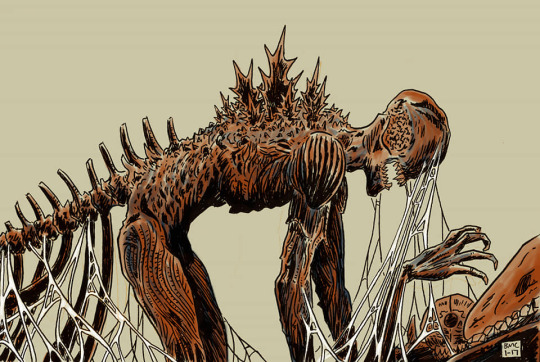
They have many names: apostles, congregants, but perhaps most commonly, newts. They're thin, wet, feral things that show little of their prior selves, or even that they were ever people at all. In time, though, they can recover their cognizance, their memories, and even a semblance of their personalities. But make no mistake; they are born again, and possess the relentless zeal of the converted.
Newts are the beginning of their transformation, not the end, and many of the most powerful servants of the dragons began as newts before growing and changing into something more. Or less, depending on how you look at it.

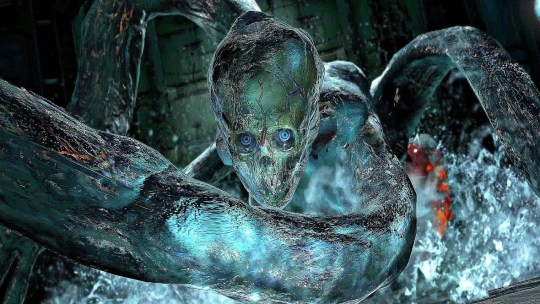
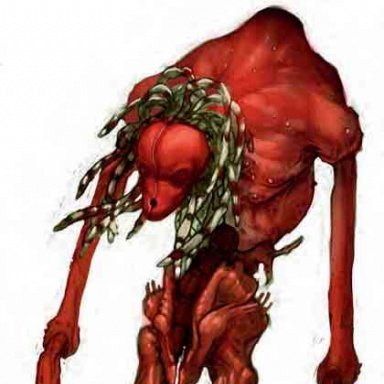

Perhaps the most frightening of these are the priest castes, who serve the capricious wills of the dragons directly and can bend the hearts of men and beast alike. Their faces are strange, chitinous masks bisected down the middle, which hide the morass of spiritual probes and sensors and miscellaneous organs that permits them to vivisect the soul of their victims with shocking ease and surgical precision. Notable subtypes include Confessors, who possess a single enormous eye whose gaze lays every secret bare; Reconcilers, who reweave their victims minds into sleeper agents and fanatics; and Eucharites, who are perhaps most important of all for they facilitate the rite of communion, in which the faithful touch the minds of their god and the aspirating are transubstantiated.
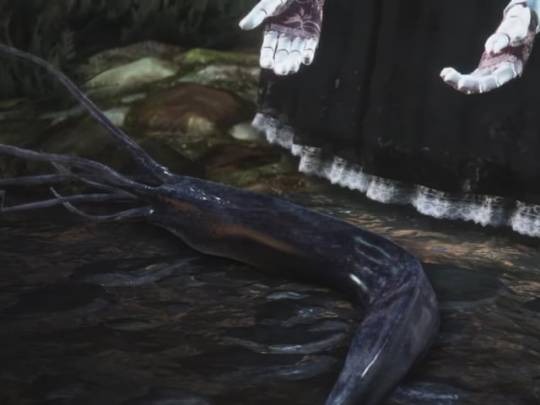
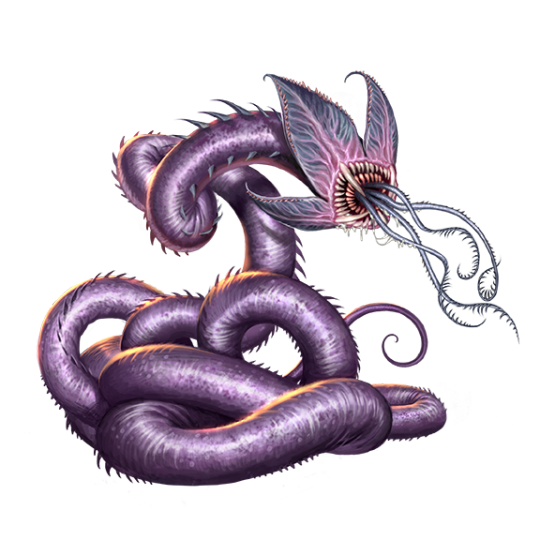

(Kos art by @ashuldur on twitter)
Communion can look very similar to conversion, in that most of the original person is broken down and remade in the image of the dragons, but communion is by definition a voluntary affair and that makes all the difference. The other primary distinction, as mentioned earlier, is that transubstantiation begins from the inside out. The aspirant consumes a small, tadpole-like spawn called a coadjutor, which essentially unravels itself and interweaves with their brain and through it, the ketrah, bridge to the higher soul. This allows them to hear the voice of the dragon and partially safeguards them against the deleterious effects of wormlight, the radiation-like energy that is emitted when dragonfire frays the weaving of the world.
A second and third communion are required for the aspirant to complete their changes: the second transforms the gut, or more specifically the gharmah, the spiritual organ that functions as a "cauldron" of sorts and lets the body absorb the magical energies of what it eats, drinks, or breathes in. Transmuted, it becomes a fragment of the dragon's hunger, a furnace that would burn the world to satiate themselves if only they could open their jaws wide enough. With this terrible hunger comes terrible power, and should they manage to feed it enough (on blood and ichor, flesh and bone, spell and soul and whatever else holds divine power in its substance) it will become less like a stomach and more like a blasphemous reactor, font of their very own dragonfire.
The third communion transforms the heart and its spiritual equivalent, the yamah, binding together the will of the dragon and the hunger of the dragon and prepares the aspirant for their final ascension, in which they are essentially eaten alive by their elders. Or rather, their old flesh is torn away and the transmuted brain, heart and gut ,nestled in a grub-like core a few feet long, is revealed. It is from this that the will regrow, remade and inhuman but very much still themselves.
#amalaposting#worldbuilding#body horror I guess#sorry if this is incoherent or poorly written but I just wanted to get the ideas down and out into the world#but I've been thinking about these a good bit and wanted to share
3 notes
·
View notes
Text
I keep trying to write down things for my worldbuilding project, but I keep getting distracted by more cool things to not write down.
#worldbuilding is a labor of love and love is pain#but when I do get my executives functioning y'all are gonna love it#amalaposting
2 notes
·
View notes
Text
I'm falling into the Sanderson pit, I can feel it. I keep going back and thinking about my magic system(s) instead of my actual story.
#amalaposting#sorta#I might actually talk about amalan magic here soonish#not sure if people would be interested but it's my blog and you signed up for this
1 note
·
View note
Text






Also a collection of memes from the campaigns I've run in Amala, which IMHO give a good taste of the sort of shit I'm on
#amalaposting#feel free to ask for context if you want#but be warned a lot of it is convoluted and bonkers even with context
0 notes
Text

Okay I actually said a fair bit in the tags. How I picture Asherah
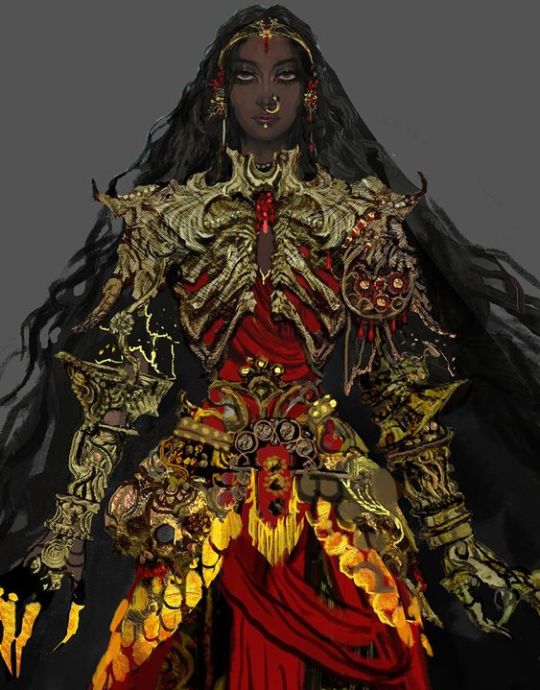
And Ansu (no clue on the source)

God I wish my brain didn't shut down the moment I try to actually write down anything about my OCs/ideas/etc. I've got some freaks knocking around in here y'all would go wild for.
#Obviously not exactly but close!#amalaposting#both very south asian#the era they lived in was basically kingdom death by way of the indian epics
15 notes
·
View notes
Text
Aaand we've got a three way tie. Luckily I'm incredibly enthusiastic and autistic, so I'll be doing all three in the coming days
So I've decided that I will be sharing more about my setting, but until I can work out how to start with the whole shebang I've decided to start off by showing off the results of my shameful little habit: taking fantasy tropes and turning them into something really really different. So I'll post a bit about my version of whatever option wins, and a bit more than that if people like. So which are people interested in:
-Dragons (the nuclear Kaiju frenemies of the gods)
-Elves (faerie support staff/narrative elements that adapted by developing sentience)
-Hell (one of the great acts of hubristic rebellion and misguided parasocial affection marred the otherwise peaceful afterlife with the birth of the first Hell, but it would not be the last)
-Celestial Bodies (and their complex relationships with each other, the other higher powers, and how they fall)
-Goblins (Do not speak to goblin-folk, do not buy their fruits...)
-Witches and Warlocks (the two oldest and most dangerous paths to power: those who find their own truth and those who bind themselves to forbidden gods to transcend the limits of humanity)
#amalaposting#worldbuilding#I hope people dig it when I start posting in earnest#I think I'll start with dragons or astronomy b/c that also covers a lot of the cosmology and metaphysics that makes groking magic easier#prob dragons bc they're very cool#nuclear satanic kaiju ecosystems in a codependent toxic incestuous relationship with the gods baybee
8 notes
·
View notes
Text
I'm actually going to elaborate a bit. Still wanting to do like a well written, nice sounding post but I wanna share the ideas I have knocking around in my head.
Dragons in Amala (the name of the setting) are probably the most divergent from the traditional archetype, but I think they're pretty cool. The tldr of them is that when the OG gods were creating Amala they underwent a sort of divine suicide/lobotomy by way of cutting out the parts of them that were chaotic/self destructive/not conducive to the orderly universe they were trying to make. So they excised those parts and became the Archons, the ten gods of law that rule the universe. The excised parts became the Dragons, who are mostly country sized masses of protean parasitic/symbiotic flesh that were imprisoned in the five moons. Things have changed since that point at 3/5 moons are compromised, however, so the Flesh Primeval has escaped and exists as monsters of various sorts. It can also turn you into a vampire if you eat it
However, there's another part to the Dragons, essentially their "souls", called the Daevas. They aren't as ravenous or rampage-y as their bodies are, but still hate Heaven/the Archons and while they're much reduced in power they have a lot of their pre-sundering knowledge and have used that to challenge the authority of Heaven by teaching humans shit they're not supposed to know. The relationship between humanity and the gods used to be much more adversarial if not downright predatory and before humanity managed to make Heaven come to the negotiation table and stop that shit the magical secrets the Daevas taught them were the only ways humanity could level the playing field a bit. The Covenant of the New Dawn (the peace treaty between humans and Heaven, named because they secured the negotiation by murdering the sun god and storming heaven in the hijacked sun) forbids using Daevic magic but witches gonna witch and the people who turn to it tend not to be particularly fond of heaven's laws anyway.
The Covenant also forbids being a warlock, but Amalan warlocks are also kinda different. It involves forming a bond with a spirit of some kind, but rather than them serving as lofty patrons a la D&D they're much more kind of desperate and possessive. The spirit invests the warlock with some degree of supernatural power in exchange for essentially getting to live inside their soul, something which is *profoundly* heretical under the Covenant (though sainthood is essentially the same thing except with orthodox spirits, and is very Silt Verses). The power balance can vary wildly, with some warlocks being manipulated and coerced by their (patron? Coadjutor? Idk, haven't got a good term yet) while others essentially treat their spirits as half familiar half magical battery. The most successful and most dangerous are closer to equal and fall into a codependent spiralling relationship that ends in their annihilation or becoming something much much more than human.
So I'm still working on those lore posts and it's maybe good that I had a three way tie b/c it's made me realize that a lot of these subjects should be connected. Like I'd been writing about the Dragons and the solar system and witchcraft etc and the more I do the more I make them deeply entwined, which is super cool and gratifying but also makes trying to explain them a bit of a nightmare since everything is context for everything else. It has let me fill in some blanks in very interesting ways, though, like what are the moons? (Vestigial corpses of the gods/dragon jail) or where did humanity learn Forbidden Magic™️? (Dragon jesuses taught them to piss off God).
7 notes
·
View notes